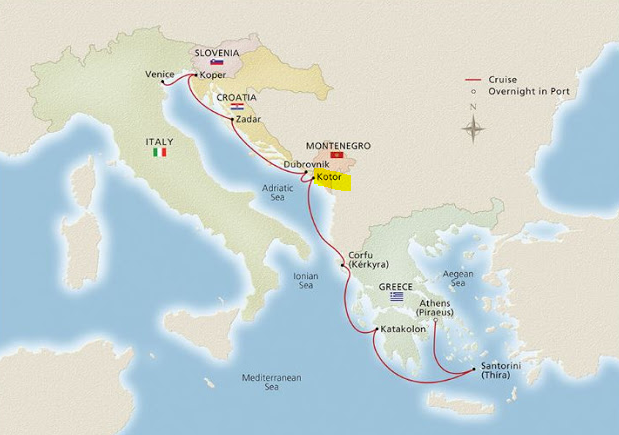Overnight we sailed to Dubrovnik, arriving around 8am. It was interesting to watch the ship turn around, back into the harbor and then move sideways to our mooring. Just after we arrived, a much larger MSC ship pulled in behind us.
Our first stop was a walking tour of Dubrovnik. Our tour guide said that it was good to go early before it became so crowded that one could barely move through the main street. The population of the old city has gone from 4,500 to only 800 residents in the past few years as homes were turned into profitable rentals. It isn't very practical to live there as no cars are allowed, delivery vehicles are only allowed until 10am and most of the residences are up sets of very high, steep and narrow steps.
Dubrovnik was an independent city state republic for 500 years, ending finally when it was captured by Napoleon in 1806. It managed to survive through this time despite the powerful Venetian Republic on one side and the Ottoman Empire on the other side by successful diplomatic and political maneuvering. It became very wealthy by being the go-between between the Ottomans and Venetians. It also helped that they cultivated the favor of the Pope by being very generous with gifts. There was an interesting flavor of democracy - the nobles didn't trust leaders so they would elect a new leader every month!
Dubrovnik has been famous for its very impressive and impenetrable city wall around the old city. One can walk the 2 miles along the top of the wall although we didn't have time to do that. Today, Dubrovnik is most famous to many fans of the HBO show "Game of Thrones" where a number of scenes were filmed. The director wanted to film some of the scenes in front of the Catholic church but the priests wouldn't allow it - the Jesuit monastery was more accommodating.
During the Balkan war in 1981, Dubrovnik was very heavily damaged by Serbian shelling with half of the city being severely damaged. On one day in December, 1981, over 3000 shells rained down on Dubrovnik. The shelling of civilians is one of the reasons that the Serb leaders were being charged with war crimes. Fortunately for Dubrovnik, it had been named a UNESCO World Heritage Site in 1979 which helped get the funding to restore the damage. It has mostly been restored to its pre-war condition.
From there we took the bus to a 250 year old olive oil mill where we could see the demonstration of the donkey-powered olive crusher. The crushed olives are then put in coconut fiber bags which are placed in the human-powered press to squeeze out the olive oil. The owner then had us to his veranda for wine and snacks (prosciutto, sausage, cheese, bread).
We then visited a water-powered grain mill and fulling mill. The fulling mill was particularly interesting as it had large wooden rams that battered cloth to give it greater strength and make it waterproof. The owner also provided samples of grappa, candied almonds, citrus and dried figs. It was pleasant to visit the mill as it was in a forested area and streams that powered the mill, making it feel cooler.
We then went to a small family farm for lunch where we had a delicious pumpkin-vegetable soup, salad, and pork with boiled vegetables, along with plenty of wine - are we seeing a pattern here. Traditional musicians playing the accordion and guitar serenaded us and led sing-alongs.
 |
| Dubrovnik outer wall and harbor |
 |
| Inside Dubrovnik |
 |
| Olive crusher |
 |
| Olive oil press |
 |
| Snack at olive mill |
 |
| Fulling mill |
 |
| Lunch establishment |










Comments
Post a Comment